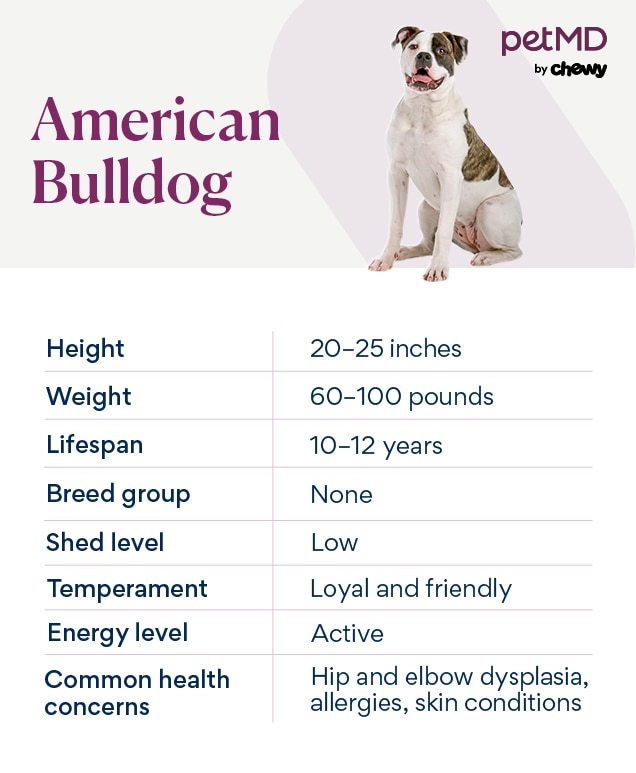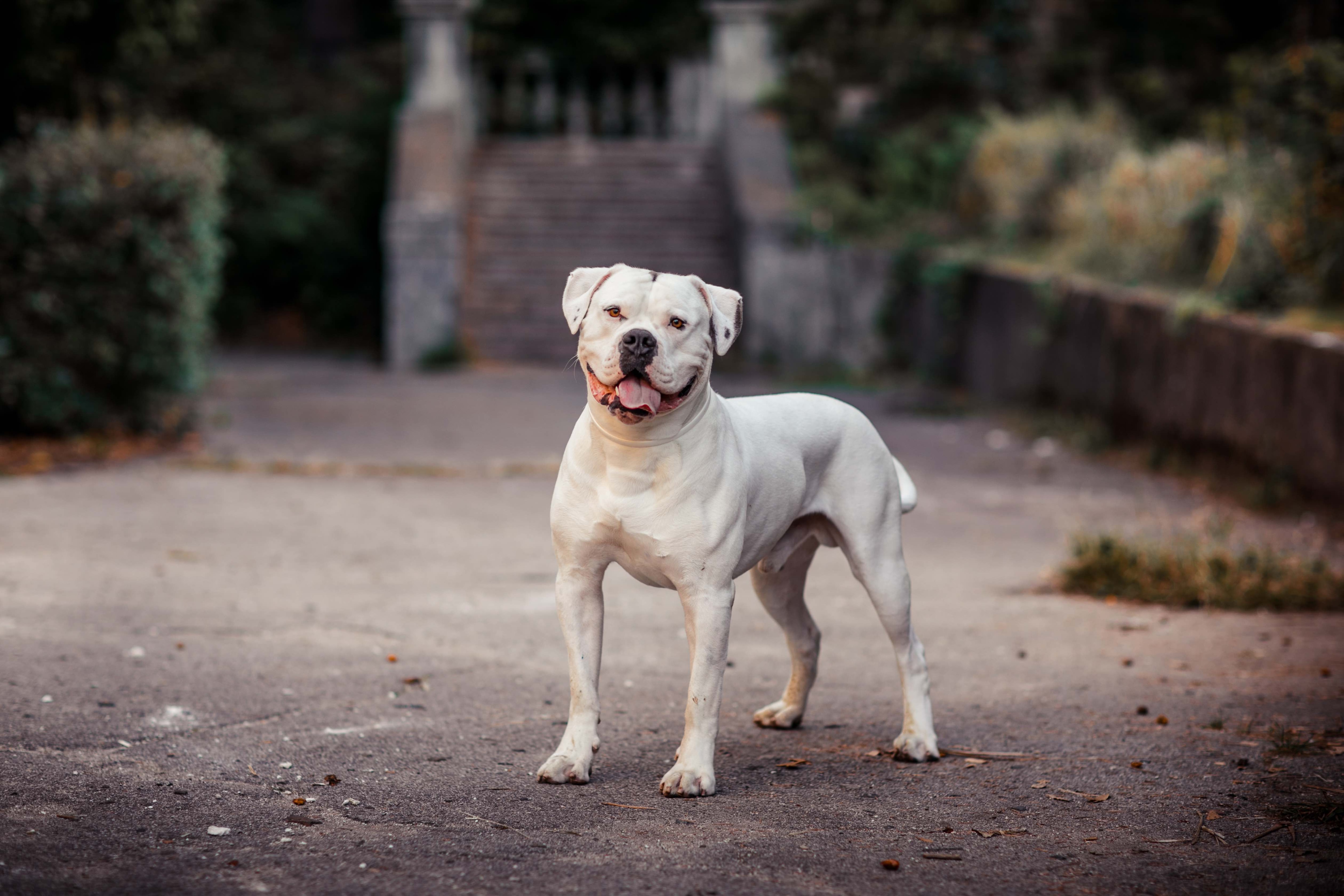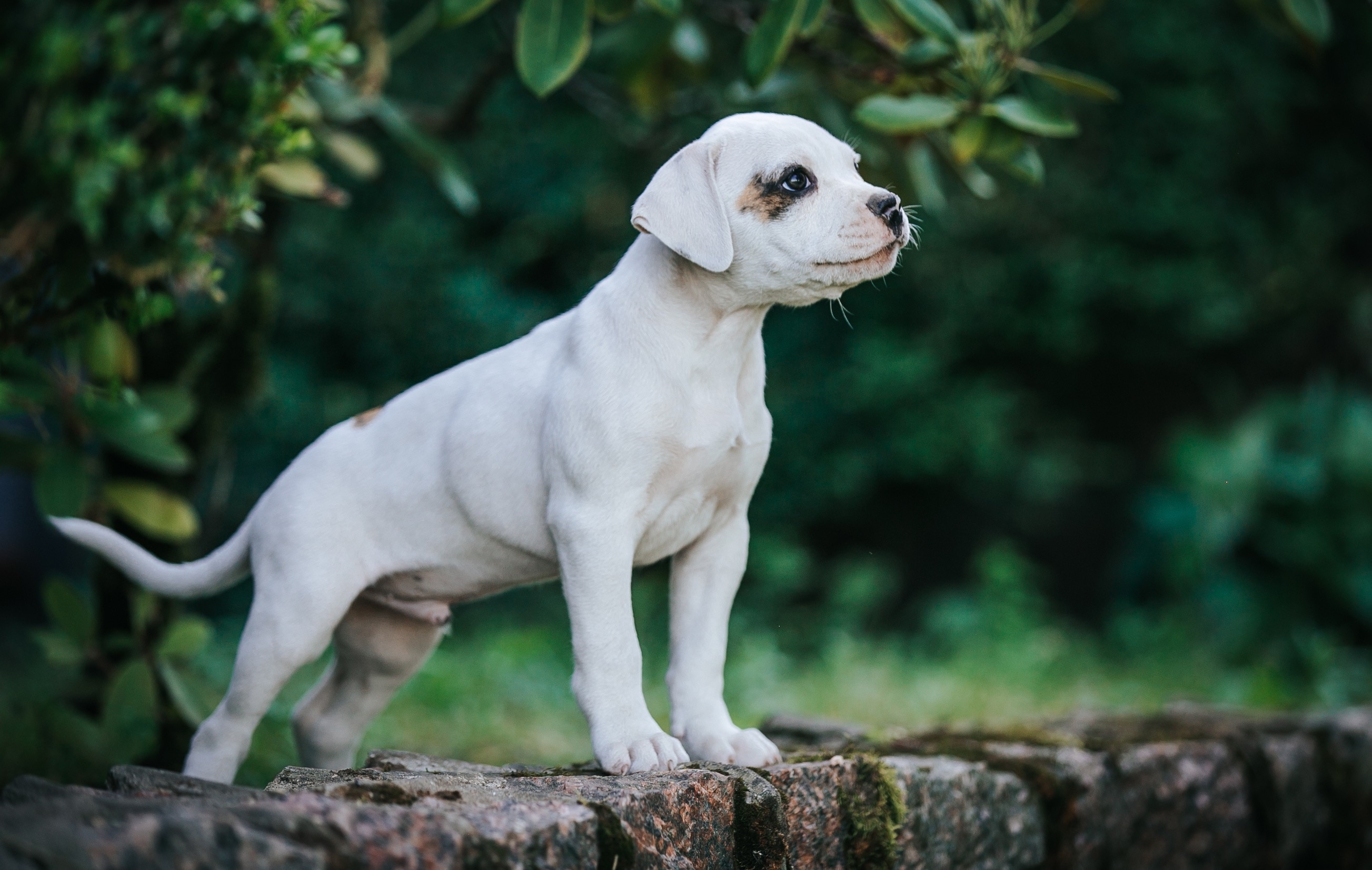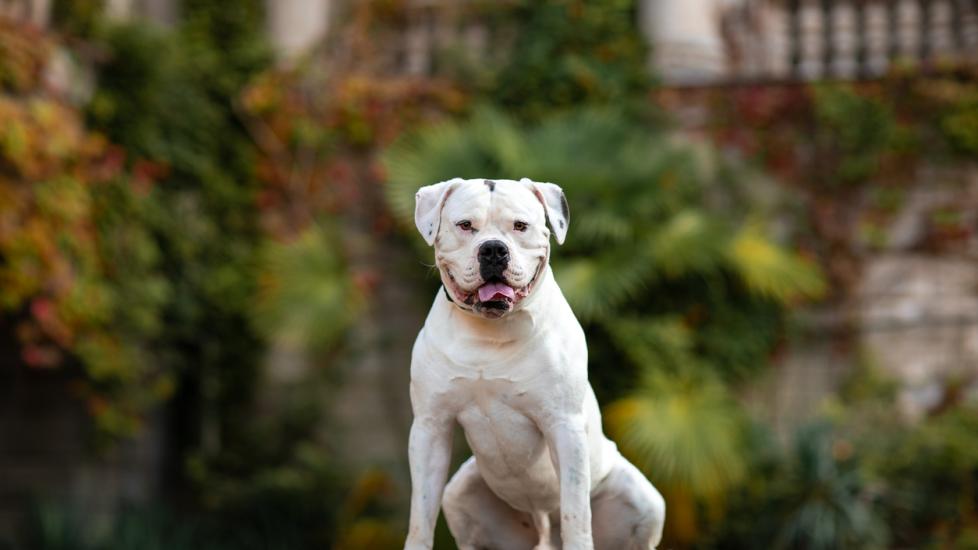American Bulldog
American Bulldogs have served a variety of jobs over the centuries: guard dogs, cattle chasers, farm dogs, and hunting partners. Though the breed has been in the United States since the 17th century, the American Bulldog started to become more popular in the late 1980s, according to the American Bulldog Association (ABA).
This medium-large, muscular breed can reach up to 25 inches tall and weigh between 60 and 100 pounds. American Bulldogs and American Bulldog mixes are generally brave and loyal animals that require dedicated training and regular activity.
Caring for an American Bulldog

American Bulldogs are loyal, intelligent, and active dogs who require focused training and plenty of exercise. They love to spend their days playing tug-of-war, running agility courses, and going on long walks with their pet parents. With proper care and attention, they can be an excellent addition to your home.
These dogs have short, mostly white coats that can have a few different-colored markings—it’s not uncommon to find a white and brindle American Bulldog or a white and black American Bulldog. No matter their color, this breed doesn’t shed a lot. But their skin care requires careful attention.
American Bulldog Health Issues
The average American Bulldog lifespan is 10–12 years. Like most dogs, there are some common health issues associated with the breed—especially with their skin.
Elbow and Hip Dysplasia
According to the ABA, American Bulldogs, like many other larger dog breeds, can be prone to elbow dysplasia and hip dysplasia. These conditions are where those joints don’t fit together properly. This can cause pain and, if left untreated, arthritis. Responsible breeders of American Bulldogs will screen their dogs for this genetic condition.
Itchy Skin
Although it’s rare, American Bulldog puppies can also be prone to a skin condition called ichthyosis, which causes the skin to flake and become itchy, according to the ABA. The disease is a genetic mutation that prevents the outer layer of skin from developing properly and can range from moderate to severe. American Bulldogs with mild cases of ichthyosis require more frequent bathing, while dogs with severe cases need to be bathed and oiled every day.
As with hip and elbow dysplasia, responsible American Bulldog breeders will test their pups for ichthyosis.
The average American Bulldog lifespan is 10–12 years. Like most dogs, there are some common health issues associated with the breed—especially with their skin.
Allergies
American Bulldogs can have allergies caused by an overactive immune system, according to the ABA. Signs that your dog has allergies include:
-
Itchy skin and scratching
-
Fur loss
-
Red skin
If you notice any of these signs in your American Bulldog, contact your veterinarian for guidance.
What To Feed an American Bulldog

A healthy American Bulldog will be well-padded, with little fat and with no ribs showing. To maintain a muscular build, the breed needs food that’s rich in protein, with limited carbohydrates.
Feeding your American Bulldog a diet formulated for large-breed dogs as both a puppy and an adult is recommended for optimal growth and wellness.
How To Feed an American Bulldog
American Bulldog puppies are typically fed three times each day. It’s important to consult with your veterinarian as you create your puppy feeding schedule, finding the right balance between meeting their nutritional needs while also warding off digestive problems or obesity.
As American Bulldog puppies mature, feeding them two meals a day is recommended. Pet parents should look for options approved by the Association of American Feed Control Officials (AAFCO) when choosing food.
How Much Should You Feed an American Bulldog?
The amount of food pet parents provide daily depends on their individual dog’s needs and lifestyle. The bag of AAFCO-approved dog food will give you guidance on portions based on your dog’s weight, but it’s also a good idea to ask your veterinarian.
Nutritional Tips for American Bulldogs
Avoid feeding your dog table scraps, which may be dangerous to their health. Treats should make up only 10% of your dog’s calorie intake and never replace a diet.
Dogs fed a complete and balanced commercial food diet should not need any nutritional supplements unless recommended by a veterinarian. That’s why it’s so important to pick a food that’s catered to your American Bulldog’s life stage (puppy, adult, or senior).
Behavior and Training Tips for American Bulldogs
American Bulldog Personality and Temperament
American Bulldogs are generally outgoing and friendly, according to the ABA. Because they are so loyal to their family, they may bark to alert you when anything seems amiss. A well-trained and socialized American Bulldog can typically get along with other pets and with young children.
American Bulldog Behavior
American Bulldogs can be watchful over their family and, as with every other dog breed, early training and socialization is vital. They are large, active dogs who need to be kept busy physically and mentally. Playtime and long walks are important for American Bulldogs—though they also enjoy a good afternoon nap.
A well-trained and socialized American Bulldog can typically get along with other pets and with young children.
American Bulldog Training
American Bulldogs are a large, active breed that require dedicated training. Luckily, they are a smart breed that’s eager to please. They can pick up training cues quickly, especially when training sessions are done consistently and with positive reinforcement.
Fun Activities for American Bulldogs
-
Tracking
-
Lure coursing
-
Tug-of-war
American Bulldog Grooming Guide
American Bulldogs require a moderate level of grooming and care. While their short coat is easier to maintain than long-haired dogs, their wrinkles and skin need lots of attention.
Skin Care
Like most dogs, American Bulldogs should be bathed when they are dirty or smelly. But the American Bulldog’s wrinkles require special attention—it’s important to keep them clean from dirt and any other crud that might build up, or skin infections can occur. Pet parents might also need to wipe down their facial folds throughout the day to remove lingering dog food crumbs.
Coat Care
American Bulldogs have a short, low-maintenance coat, and pet parents can brush them weekly to catch any loose hairs. This routine keeps their coat looking healthy—and they will love the attention. Grooming time is also a great chance to check for cuts, flea bites, or other problems.
Eye Care
American Bulldogs typically don’t require any special eye care. Some dogs, especially white American Bulldogs, can get brown discoloration around their eyes from tearing. Gentle cleaning with an eye cleaning solution can help minimize these tear stains.
Ear Care
Bulldogs can be susceptible to ear wax buildup, so it’s important to clean your dog’s ears once a week using a vet-recommended ear cleanser.
Considerations for Pet Parents

Before bringing home an American Bulldog puppy, it’s important to consider your lifestyle. Are you a jogger or do you like to go on long weekend hikes? An American Bulldog can fit right in. These dogs won’t do well in a low-energy home without outlets for their physical energy.
American Bulldog FAQs
How long do American Bulldogs live?
The average American Bulldog lifespan is 10–12 years.
Is an American Bulldog a good family dog?
With proper training and exercise, the American Bulldog can be a great addition to your family. Breed experts recommend early and consistent socialization and obedience training for this intelligent and energetic breed. American Bulldogs bond strongly with their family, according to the American Bulldog Rescue.
Is an American Bulldog a Pit Bull?
Sort of! According to the Animal Humane Society, the American Pit Bull Terrier isn’t truly a dog breed—the term refers to a group of breeds, including American Bulldogs, American Staffordshire Terriers, and Staffordshire Bull Terriers, and various mixes between these breeds.
How much does an American Bulldog cost?
Purebred American Bulldogs can cost more than $1,000, though you can also find American Bulldogs (and puppies!) in shelters and rescues.
Featured Image: iStock/Yuliya Golland
